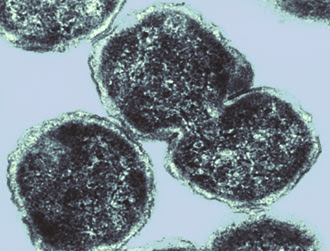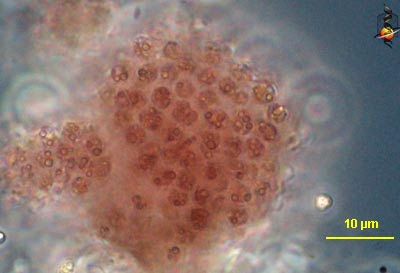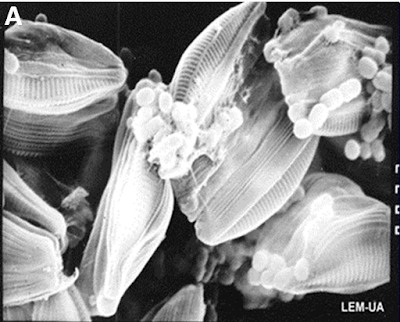Belongs within: Alphaproteobacteria.
Contains: Paracoccus.
The Rhodobacteraceae are a diverse group of Gram-negative bacteria including both photo- and chemoheterotrophic taxa, primarily found in aquatic environments.
Rhodobacteraceae [Rhodobacterales]
|--+--Oceanicaulis Strömpl, Hold et al. 2003 SH03
| | `--*O. alexandrii Strömpl, Hold et al. 2003 SH03
| `--Maricaulis SH03
| |--M. parjimensis SH03
| `--+--M. maris SH03
| `--M. washingtonensis SH03
`--+--+--Hirschia baltica SH03
| `--Hyphomonas SH03
| |--H. jannaschiana SH03
| `--H. polymorpha SH03
`--Caulobacteraceae [Caulobacterales] GH01
|--Asticcacaulis GH01
|--Phenylobacterium GH01
|--Brevundimonas GH01
| |--B. diminuta SH03
| `--B. vesicularis IT03
`--Caulobacter SH03
|--C. crescentus IT03
`--C. vibrioides SH03
Rhodobacteraceae incertae sedis:
Rhodobacter MK03
|--R. azotoformans I01
|--R. blasticus [=Rhodopseudomonas blastica] I01
|--R. capsulatus MK03
|--R. sphaeroides I01
`--R. veldkampii I01
Ahrensia GH01
Amaricoccus GH01
Antarctobacter GH01
Gemmobacter GH01
Octadecabacter GH01
Paracoccus GH01
Rhodovulum GH01
|--R. adriaticum [=Rhodobacter adriaticus, Rhodopseudomonas adriatica] I01
|--R. euryhalinum [=Rhodobacter euryhalinus] I01
|--R. strictum I01
`--R. sulfidophilum [=Rhodobacter sulfidophilus, Rhodopseudomonas sulfidophila] I01
Roseivivax GH01
|--R. halodurans I01
`--R. halotolerans I01
Roseobacter GH01
|--R. denitrificans I01
`--R. litoralis I01
Roseovarius tolerans GH01, I01
Rubrimonas cliftonensis GH01, I01
Ruegeria GH01
Sagittula GH01
Staleya GH01
Stappia GH01
Sulfitobacter GH01
*Type species of generic name indicated
REFERENCES
[GH01] Garrity, G. M., & J. G. Holt. 2001. The road map to the Manual. In: Boone, D. R., R. W. Castenholz & G. M. Garrity (eds) Bergey’s Manual of Systematic Bacteriology 2nd ed. vol. 1. The Archaea and the Deeply Branching and Phototrophic Bacteria pp. 119–166. Springer.
[I01] Imhoff, J. F. 2001. The anoxygenic phototrophic purple bacteria. In: Boone, D. R., R. W. Castenholz & G. M. Garrity (eds) Bergey’s Manual of Systematic Bacteriology 2nd ed. vol. 1. The Archaea and the Deeply Branching and Phototrophic Bacteria pp. 631–637. Springer.
[IT03] Inagaki, F., K. Takai, H. Hirayama, Y. Yamato, K. H. Nealson & K. Horikoshi. 2003. Distribution and phylogenetic diversity of the subsurface microbial community in a Japanese epithermal gold mine. Extremophiles 7: 307–317.
[MK03] Mori, K., H. Kim, T. Kakegawa & S. Hanada. 2003. A novel lineage of sulfate-reducing microorganisms: Thermodesulfobiaceae fam. nov., Thermodesulfobium narugense, gen. nov., sp. nov., a new thermophilic isolate from a hot spring. Extremophiles 7: 283–290.
[SH03] Strömpl, C., G. L. Hold, H. Lünsdorf, J. Graham, S. Gallacher, W.-R. Abraham, E. R. B. Moore & K. N. Timmis. 2003. Oceanicaulis alexandrii gen. nov., sp. nov., a novel stalked bacterium isolated from a culture of the dinoflagellate Alexandrium tamarense (Lebour) Balech. International Journal of Systematic and Evolutionary Microbiology 53: 1901–1906.














